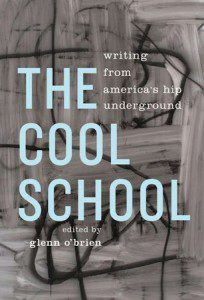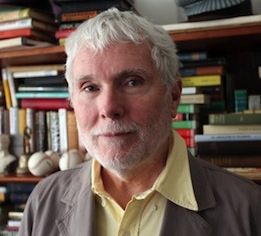
First, the title: one wonders what Glenn O’Brien is up to. Maybe he wants to codify coolness, to collect all of the coolest writing he’s come across in a forty-year career that spans editorships at Interview, Rolling Stone, and Spin and create a School of Cool. Stable coolness is bit of a paradox, though—cool is mercurial, contingent upon time and gender and race (for starters), so what The Cool School gives us is one sixty-something educated white man’s perspective in the form of memoirs, poems, novels, comedy routines, letters, essays, and song lyrics… basically, whatever he wants.
“My guiding principle in selecting was filtered randomness,” O’Brien says in the book’s introduction. “My only agenda was to provide a primer and inspiration for future thought crime and written rebellion.” That’s a nice sentiment, but ostensibly he’s out to make some money, too: famous names like Miles Davis, Neil Cassady, Bob Dylan, and Andy Warhol adorn pieces of ho-hum writing; one gets the sense that their pieces were selected for byline more than content. Miles’ music might epitomize cool, but check out his excerpted biography:
I began to meet people like Jimmy Cobb and Dexter Gordon as I lived around Harlem, the Village, and 52nd Street. Dexter called me “Sweetcakes” because I was drinking malted milks and eating cakes, pies, and jelly beans all the time.
Not exactly compelling stuff. Fortunately, other celebrities do better: excerpts from Hunter S. Thompson’s gonzo classic Fear and Loathing in Las Vegas and Lenny Bruce’s comedy are too funny to read in public, and Norman Mailer’s “The White Negro” is as forward-looking as it is frustrating:
… the organic growth of Hip depends on whether then Negro emerges as a dominating force in American life. Since the Negro knows more about the ugliness and danger of life than the white, it is probable that if the Negro can win his equality, he will possess a potential superiority, a superiority so feared that the fear itself has become the underground drama of domestic politics.
Mailer’s essay in particular is frustrating because in the sixty-eight years since he wrote it, the ugliness and danger he speaks of has been turned into a moneymaking machine, equality still seems a long way off, and fear is anything but underground in domestic politics, as anyone within spitting distance of a TV this summer could’ve told you.
The Cool School is most relevant when it, like Mailer, pauses from trying to be hip and dissects hipness instead. Anatole Broyard, one just six writers of color in a fifty-seven-person cast, does this beautifully in “A Portrait of the Hipster”:
Jive music and tea were the two most important components of the hipster’s life. Music was not, as has often been supposed, a stimulus to dancing. For the hipster rarely danced, he was beyond the reach of stimuli. If he did dance, it was half parody—“second removism”—and he danced only to the off-beat, in a morganatic one to two ration with the music.
(“Tea” is marijuana, and “morganatic,” apparently, means “of or denoting a marriage in which neither the spouse of lower rank nor any children have any claim to the possessions or title of the spouse of higher rank.”) This is great stuff: funny, insightful, and eerily familiar. Jack Kerouac, in his usual rambling style, also waxes theoretical about hipsters in “The Origins of the Beat Generation,” though is perhaps too self-involved to get anywhere meaningful. For something with more bite, there’s Seymour Krim’s “Making It,” which juxtaposes two voices to ironize both sides of the cultural divide:
What happened to the world out there, the one you always thought you loved an honestly-couldn’t-get-enough-of-without-wanting-a-sou-in-return for your pure and holy feelings? Baby, that world went up in the cornball illusions of yesterday! Forget it just like it never knew you were alive… This world (nuts, this rotting universe!) is a Mt. Everest, kiddo, and you’ve got to start climbing now or the dumbwaiter of this age will slam you down into the black basement.

These pieces give the reader some ideological building blocks to play with, and show that the modern hipster’s problems—enlightened selfishness, nebulous sense of identity, superficial coolness—aren’t as new as they seem.
Time is not kind to coolness, particularly coolness that relies on transgressive morality. The movement of American cultural mores from the 50’s on seems linear in a way that’s different from, say, fashion, and while there’s a non-zero chance that parachute pants will cycle around to become hip again, it seems impossible that getting high can be radical when pot is legal, or extramarital sex so revelatory when Grindr lets you sort potential partners by proximity. Some pieces in The Cool School, one feels, draw their hipness from a well that has since run dry. We traded repressive morality for relative freedom, but we lost a path toward coolness.
The Beats and the hippies and the punks paved the way for the freedom we enjoy today, but the advantage of hindsight demonstrates where trailblazers missed the mark completely, as in Neal Cassady’s letter to Jack Kerouac:
Knowing her supremely perfect being was completely mine (when I’m more coherent, I’ll tell you her complete history & psychological reason for loving me) I could conceive of no obstacle to my satisfaction, well, “the best laid plans of mice & men go astray” and my nemesis was her sister, the bitch.
Not cool. Female conquest and objectification might made Cassady “cool” in his time but judged by today’s standards, he’s a creep, One wonders at O’Brien’s motive for including this piece, especially because, of the fifty-seven artists the editor selected for The Cool School, nine are women, and only two of those, Lynne Tillman and Emily XYZ, engage with feminism. Five of the pieces written by women are male-centric. To limit a hugely significant movement to two texts in The Cool School means O’Brien has deluded himself into thinking either a.) feminism isn’t cool or b.) one short story and one poem give us the whole story or c.) he isn’t responsible for the viewpoints he’s disseminating.
It’s tough to say whether The Cool School is cool. To do so would reduce its ensemble of writers to a single unit, and while that group may not be as diverse as one kid from Generation Y would like. O’Brien’s picks were cool for their time, but judging by today’s standards, many of them fall short. The editor’s setups show that he isn’t out to expose flaws in old conceptions of cool: Neil Cassady isn’t a misogynist, he’s a “legend,” Emily XYZ’s poetry isn’t about feminism, it’s “about the power of voice to bring words alive.”
This book cannot be “a guide to future thought crime,” as O’Brien intends, unless we impose our own, up-to-date ideas of cool on these beatniks, hippies, and punks. They pointed the way toward a cultural pluralism that’s still being worked out, and even if it wasn’t the editor’s intent, it’s a relief to see that they got some of it wrong. Maybe we’re getting some of it right.




